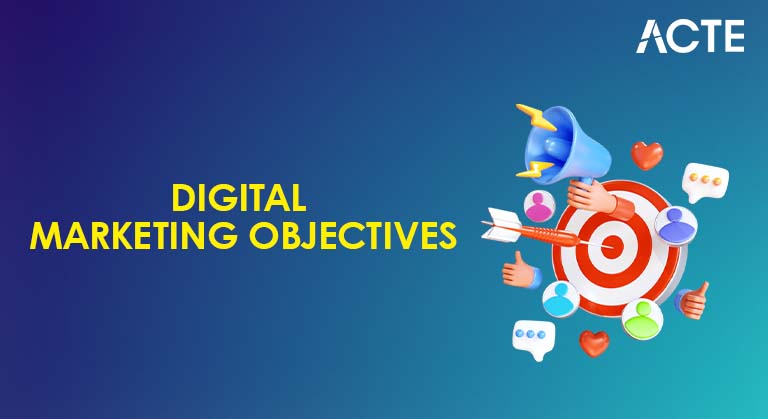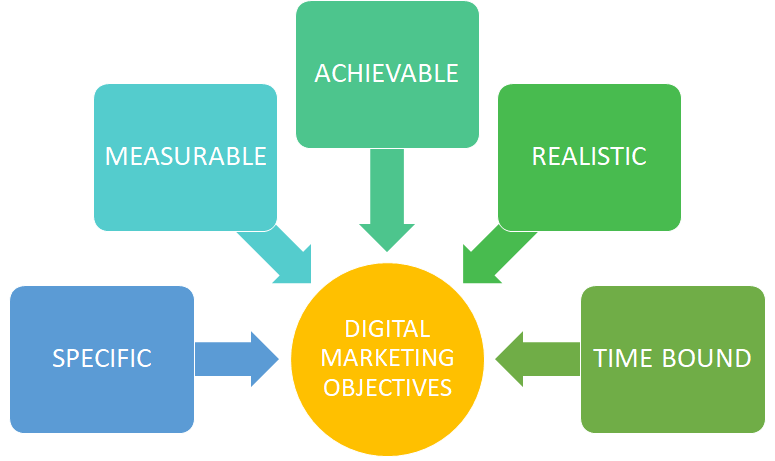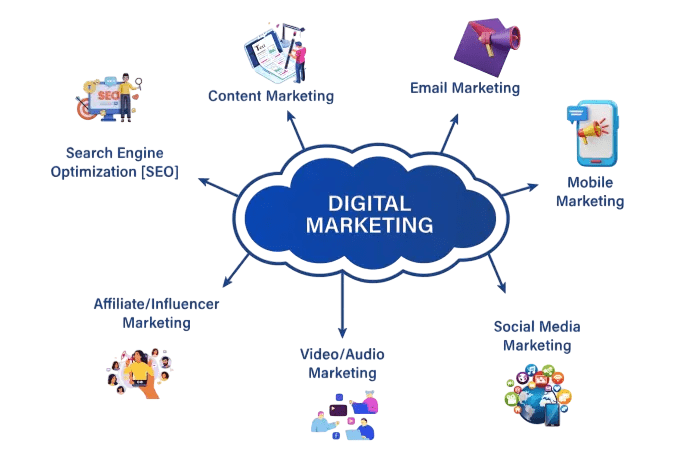
- Introduction
- What Are Digital Marketing Objectives?
- Why Are Digital Marketing Objectives Important?
- How to Set Effective Digital Marketing Objectives
- Common Digital Marketing Objectives and Examples
- Aligning Objectives with Different Digital Marketing Channels
- Measuring and Tracking Your Digital Marketing Objectives
- Challenges in Setting and Achieving Digital Marketing Objectives
- Best Practices for Successful Digital Marketing Objectives
- Conclusion
Introduction
In an era where digital presence defines business success, digital marketing has emerged as the most vital tool to reach customers, build brand value, and increase revenue. But with countless tactics and platforms available, how do businesses ensure their efforts are purposeful and measurable? The answer lies in setting clear digital marketing objectives. These objectives not only direct your campaigns but also provide benchmarks to measure success and refine strategies.This article explores everything you need to know about digital marketing objectives from their definition and importance to how you can set, measure, and optimize them for the best results.Digital marketing objectives are the specific goals that businesses aim to achieve through online marketing efforts. These objectives guide the planning, execution, Digital Marketing Training and measurement of digital campaigns across various platforms such as search engines, social media, email, and websites. Unlike traditional marketing, digital marketing provides highly targeted, data-driven strategies that allow brands to reach the right audience at the right time. The main objectives typically include increasing brand awareness, generating leads, driving website traffic, improving customer engagement, and ultimately boosting sales and revenue. Setting clear and measurable digital marketing objectives is essential for ensuring that every strategy and tactic contributes to business growth. With evolving technology and consumer behavior, these objectives must also be flexible, scalable, and aligned with the overall marketing goals of the organization.
Ready to Get Certified in Digital Marketing? Explore the Program Now Digital Marketing Online Training Offered By ACTE Right Now!
What Are Digital Marketing Objectives?
Digital marketing objectives are clear, specific goals set by businesses to achieve desired outcomes through their online marketing initiatives. Unlike broad business goals such as “increase revenue” or “grow the brand,” digital marketing objectives break down these ambitions into measurable targets like increasing website traffic, Monetized on your YouTube Channel, boosting social media engagement, or generating qualified leads. These objectives typically follow the SMART framework; they should be Specific, Measurable, Achievable, Relevant, and Time-bound. For example, “Increase organic website traffic by 25% in the next six months” is a precise objective compared to a vague “Increase traffic.”Digital marketing objectives are the specific, measurable goals that a business sets to achieve through its online marketing efforts. These objectives provide direction and purpose for digital campaigns across platforms like search engines, social media, email, websites, and mobile apps. The core aim is to use digital tools and strategies to support overall business growth. Common digital marketing objectives include increasing brand awareness, generating high-quality leads, driving website traffic, boosting customer engagement, and improving sales conversions. Other goals may involve enhancing online visibility, building customer loyalty, or improving search engine rankings.

Setting clear digital marketing objectives is essential because it helps marketers track performance, allocate resources effectively, and measure return on investment (ROI). These goals should follow the SMART framework Specific, Measurable, Achievable, Relevant, and Time-bound to ensure they are practical and results-driven. Ultimately, well-defined digital marketing objectives align marketing efforts with business priorities, helping brands grow their online presence and connect more effectively with their target audience.
Why Are Digital Marketing Objectives Important?
Setting digital marketing objectives brings numerous benefits:
- Provide Direction and Focus: They guide your team’s efforts and keep campaigns aligned with business goals, preventing scattered and ineffective activities.
- Enable Measurement and Optimization: With objectives in place, you can track progress through data and analytics, understand what works, Click-Through Rate in Digital Marketing and optimize campaigns for better performance.
- Improve ROI: Focused efforts on specific, measurable goals help avoid wasted spend and resources, ensuring your marketing budget generates maximum return.
- Facilitate Accountability: Clear objectives establish expectations for teams and individuals, promoting responsibility and transparent performance assessment.
- Enhance Communication: Objectives clarify priorities both internally and externally, enabling better collaboration and clear reporting to stakeholders.
- Ensure that your digital objectives support overall business ambitions such as sales growth, market expansion, or customer retention.
- Perform a thorough audit of your current digital marketing performance, competitor landscape, and audience insights.
- Knowing your audience’s demographics, preferences, and online behavior helps tailor objectives that resonate and perform well.
- Select KPIs like traffic, leads, conversion rates, Digital Marketing Metrics or engagement metrics that clearly indicate progress.
- Each objective must be specific, measurable, achievable, relevant, and time-bound.
- Focus on key objectives that will have the greatest business impact rather than spreading resources too thin.
- Outline the strategies, tactics, timelines, and responsibilities necessary to achieve your objectives.
To Explore Digital Marketing in Depth, Check Out Our Comprehensive Digital Marketing Training To Gain Insights From Our Experts!
How to Set Effective Digital Marketing Objectives
Setting impactful digital marketing objectives involves a strategic approach:
Step 1: Align with Business Goals
Step 2: Analyze Your Current Situation
Step 3: Define Your Target Audience
Step 4: Choose Relevant Metrics
Step 5: Make Objectives SMART
Step 6: Prioritize Objectives
Step 7: Develop an Action Plan
Common Digital Marketing Objectives and Examples
Digital marketing objectives help businesses stay focused and measure the success of their online strategies. These goals vary depending on the company’s needs, audience, and industry. Below are some of the most common Digital Marketing Training objectives, along with practical examples for each:
-
Increase Brand Awareness
- Objective: Make more people aware of your brand online.
- Example: Run targeted social media ads to reach 100,000 users in a specific region within one month. Drive Website Traffic
- Objective: Attract more visitors to your website.
- Example: Increase monthly website visits by 25% through SEO and blog content over the next 3 months. Generate Leads
- Objective: Collect contact information from potential customers.
- Example: Use lead magnets like eBooks or free trials to gain 500 new email subscribers in 60 days. Boost Sales or Conversions
- Objective: Increase online purchases or other valuable actions.
- Example: Improve product page conversion rate by 15% through A/B testing and UX improvements. Improve Search Engine Rankings
- Objective: Rank higher for important keywords on search engines.
- Example: Achieve a top 3 ranking on Google for five targeted keywords within 6 months. Enhance Customer Engagement
- Objective: Interact more effectively with your audience.
- Example: Grow social media comments and shares by 40% through interactive posts and stories. Build Customer Loyalty and Retention
- Objective: Encourage repeat business and brand loyalty.
- Example: Increase repeat purchases by 20% through email marketing and loyalty rewards over 3 months.
- SEO: Best for improving organic traffic, search rankings, and brand authority.
- PPC Advertising: Ideal for driving quick traffic, leads, and sales with targeted ads.
- Social Media Marketing: Effective for building brand awareness, engagement, and loyalty.
- Content Marketing: Supports thought leadership, SEO, and lead nurturing.
- Email Marketing: Focused on retention, Display Advertising, nurturing leads, and driving conversions.
- Unrealistic Expectations: Setting goals without considering resources or Inbound Marketing,market conditions.
- Poor Data Quality: Incomplete or inaccurate data leading to wrong conclusions.
- Changing Trends: Rapid shifts in technology and consumer behavior requiring agility.
- Disjointed Strategies: Lack of coordination across channels leading to inefficiency.
- Skill Gaps: Teams lacking necessary expertise to execute plans effectively.
Looking to Master Digital Marketing? Discover the Digital Marketing Expert Masters Program Training Course Available at ACTE Now!
Aligning Objectives with Different Digital Marketing Channels
Each channel excels in supporting specific objectives:

Understanding channel strengths helps in selecting the right platform to achieve your objectives efficiently.
Measuring and Tracking Your Digital Marketing Objectives
Measuring and tracking your digital marketing objectives is essential to determine whether your strategies are effective and delivering the desired results. Without proper measurement, it’s impossible to know if you’re meeting your goals or wasting valuable resources. The process starts by setting clear, SMART objectives Specific, Measurable, Achievable, Relevant, and Time-bound. Once goals are in place, you need to identify key performance indicators (KPIs) that align with each objective. For example, if your goal is to increase website traffic, Benefits of being a Content Marketer, KPIs might include unique visitors, page views, or bounce rate. Using tools like Google Analytics, Google Search Console, social media insights, and email marketing platforms, marketers can track performance in real-time. For paid campaigns, platforms like Google Ads and Facebook Ads Manager offer detailed metrics such as click-through rates (CTR), conversion rates, cost per click (CPC), and return on ad spend (ROAS). Regular reporting and analysis help you spot trends, identify areas for improvement, and adjust your strategies as needed. Dashboards and automated reports can simplify this process, allowing for data-driven decisions. Ultimately, consistent tracking ensures accountability and helps marketers fine-tune their efforts to achieve maximum ROI and business growth.
Challenges in Setting and Achieving Digital Marketing Objectives
Despite best efforts, some challenges persist:
Preparing for Digital Marketing Job Interviews? Have a Look at Our Blog on Digital Marketing Interview Questions and Answers To Ace Your Interview!
Best Practices for Successful Digital Marketing Objectives
To achieve real success in digital marketing, it’s essential to follow best practices when setting and pursuing your objectives. Start by ensuring your goals are SMART Specific, Measurable, Achievable, Relevant, Facebook Pixel and Time-bound. Vague objectives like “get more traffic” won’t help; instead, define clear targets such as “increase website traffic by 30% in 3 months.” Align your digital marketing goals with your overall business objectives, whether it’s growing revenue, improving customer retention, or building brand awareness.Understanding your target audience is another key best practice. Use audience data and buyer personas to guide your content, platform choices, and messaging. Focus on the right channels based on where your audience is most active this could include search engines, social media, email, or paid advertising.It’s also critical to track performance with relevant KPIs and adjust your strategy based on data insights. Regular analysis and optimization ensure your campaigns stay on track. Additionally, maintaining consistent branding, producing high-quality content, and leveraging automation tools can significantly improve efficiency and results.Finally, be flexible. The digital landscape changes quickly, so your objectives should be reviewed and refined regularly to stay competitive and relevant.
Conclusion
Digital marketing objectives are the backbone of any successful digital strategy. They provide clarity, focus, and measurable benchmarks to guide your marketing efforts toward business growth. By setting SMART objectives aligned with your business goals, carefully selecting relevant metrics, and continually measuring and optimizing performance, you can unlock the full potential of Digital Marketing Training . Whether your goal is to increase brand awareness, generate leads, improve conversion rates, or retain loyal customers, defining and executing clear digital marketing objectives is your path to sustainable online success.




